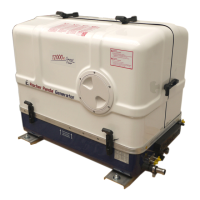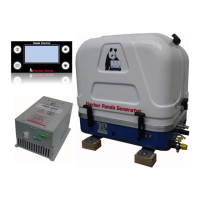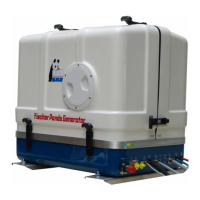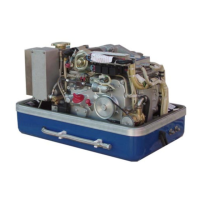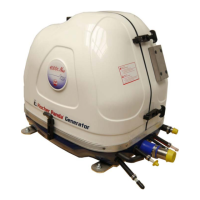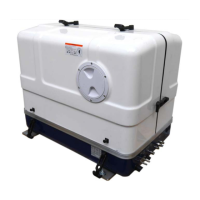Why is my Fischer Panda 8000i generator output voltage too low?
- MMaria PattersonAug 14, 2025
The generator's output voltage might be too low because the PGMi is overloaded. To resolve this, reduce the electrical load by switching off some devices.
Why is my Fischer Panda 8000i generator output voltage too low?
The generator's output voltage might be too low because the PGMi is overloaded. To resolve this, reduce the electrical load by switching off some devices.
What to do if my Fischer Panda Inverter motor stops by itself?
If the motor stops by itself, it could be due to several reasons. First, check the fuel supply system for a lack of fuel. Second, examine the cooling system for excess heat or a lack of cooling water, indicated on the remote control panel. Check the cooling water system flow, including the water pump, inlet water filter, and coolant flow in the extra heat exchanger. Lastly, check the oil level; if it's low, top it up. If the oil pressure sensor tripped, have the motor's oil pressure repaired by Kubota-Service if necessary.
Why is my Fischer Panda 8000i Inverter producing sooty, black exhaust?
A sooty, black exhaust from your Fischer Panda Inverter can be caused by several factors. It could be due to the generator being overloaded, so check the electrical load and switch off any unnecessary devices. Another cause might be insufficient intake air, in which case you should check and clean the intake air filter. Other potential causes include faulty fuel injector nozzles (replace them), incorrect valve clearance (readjust to the correct value, referring to the Kubota manual), poor fuel quality (use better quality diesel, recommended 2-D Diesel), poor combustion (have the motor serviced by Kubota due to incorrect AFR), or low compression pressure (consult the Kubota motor manual).
What to do if my Fischer Panda Inverter motor turns over but does not start?
If the motor turns over but doesn't start, several issues could be the cause. Start by checking the wire connections and circuitry to the stop solenoid valve. Also, check the fuel filter and pump, cleaning if necessary. Ensure there's enough fuel and check the fuel supply. Verify the glow plugs are working correctly and check the heating time. Inspect the fuel system for leaks and bleed any air from it. Replace the fuel filter if it's blocked. If the issue persists, low compression pressure might be the problem; consult the Kubota motor-manual.
Why does the speed of my Fischer Panda 8000i motor drop?
A drop in the motor speed of your Fischer Panda Inverter can occur due to several reasons: * Too much oil: Drain oil. * Lack of fuel: Check the fuel supply system, including the fuel filter (renew if necessary), fuel pump, and fuel lines (bleed if necessary). * Lack of intake air: Check air intake paths and clean the air filter (and intake muffler if installed). * Generator overloaded: Reduce the electrical load by switching off devices. * Defective generator: The generator must be sent to the manufacturer for repair of damaged bearings or winding. * Damaged engine: Bearing damage should be repaired by Kubota-Service.
What to do if my Fischer Panda 8000i Inverter motor does not turn over when starting?
If the motor doesn't turn over when starting, first check if the battery main switch is switched off and turn it on if necessary. Next, verify that the battery voltage is sufficient and that the connection is firm and free of corrosion. Lastly, investigate for a starting current fault by observing the voltage of full batteries, which should fall to a maximum of 11V. If the voltage doesn't drop, the wiring is severed; if it drops further, the battery is discharged.
Why does my Fischer Panda Inverter motor run irregularly?
An irregularly running motor in your Fischer Panda Inverter can be due to a faulty centrifugal injector governor, which should be inspected by a Kubota-Service technician. It can also be caused by too much air in the fuel lines, in which case you should bleed the air from the fuel system.
What to do if my Fischer Panda 8000i motor does not turn over at the normal speed during the starting process?
If the motor does not turn over at the normal speed during starting, check the starter battery voltage to ensure it is sufficient. Also, damaged bearings or a seized piston could be the cause, requiring repairs by Kubota-Service.
What should I do if there is cooling water in the combustion chamber of my Fischer Panda Inverter?
If there's cooling water in the combustion chamber: 1. Turn the generator "OFF" at the control panel. 2. Remove the glow plug. 3. Rotate the motor by hand carefully. 4. Check if there is water in the oil and change both oil and filter if necessary. 5. Determine the cause for excess water in the combustion chamber, which may be a defective air vent in the cooling water system. Check, clean, or replace the air vent if faulty.
General safety instructions, hazardous materials, fire, prohibitions, and mandatory actions.
Lists and illustrates tools required for maintenance and installation procedures.
Declaration in accordance with Machinery Directive 2006/42/EC and customer registration benefits.
Information on technical support contacts and crucial steps for initial generator start-up.
Explains the meaning of various warning and instruction signs used throughout the manual.
Covers electrical installations, generator covers, operating conditions, and voltages.
Safety instructions for cable types, cross-sections, installation, and battery handling.
Provides 5 safety steps to follow in case of electrical shock accidents.
Detailed steps for rescue breathing and checking pulse for an unresponsive adult.
Defines the generator's intended use and the manual's purpose for installation and maintenance.
Introduces the main components of the generator's i system, including the generator and control panel.
Details how to open different types of transport boxes and sound insulation capsules.
Covers generator transport, loading/unloading, and measures for extended downtimes.
Explains the type plate and provides a description of the generator's physical layout.
Detailed views of the generator's right, left, front, back, and top sides with labeled components.
Describes the Panda iControl2 panel, its buttons, and the function of its various system components.
Explains the components and schematics of the cooling, fuel, air intake, exhaust, electrical, and lubrication systems.
Details the function and location of various sensors and switches used for monitoring the generator.
Outlines personnel requirements and general hazard warnings for installation work.
Covers environmental considerations and guidelines for optimal generator placement and sound insulation.
Details the installation and connection procedures for the generator's fuel system.
Provides instructions for installing the generator's DC system, including battery connections.
Covers the installation of electrical components, external radiators, and the cooling system.
Covers radiator baseplate requirements and methods for determining the correct radiator size based on thermal load.
Specifies who is allowed to operate the generator and outlines key operational hazards.
Provides general operating guidance, including procedures for low-temperature start-up and pre-heating.
Guides on proper generator loading, avoiding light load operation, and managing overload conditions.
Details pre-start checks, starting, and stopping procedures as referenced by the remote control panel.
Defines personnel roles and outlines hazards associated with maintenance work.
Covers environmental protection during maintenance and general maintenance requirements and intervals.
Provides step-by-step instructions for checking and refilling the engine oil level.
Instructions for checking the starter battery condition, electrolyte level, and density.
Covers procedures for ventilating the fuel system and replacing the fuel filter.
Instructions for replacing the air filter and ventilating the coolant circuit to remove air.
Guides on replacing the V-belt for the cooling water pump and the electric starter motor.
Details the replacement procedures for injection nozzles, glow plugs, and the oil pressure switch.
Covers replacing the stop solenoid, valve cover gasket, and water pump for specific engine series.
Instructions for adjusting valve clearance and replacing operating current relays and fuses.
Specifies personnel roles and outlines hazards associated with generator failure troubleshooting.
Covers environmental considerations and lists necessary tools and measuring instruments for troubleshooting.
Addresses generator overloading, voltage fluctuations, and automatic shut-down mechanisms.
Guides on diagnosing issues related to the fuel solenoid valve, stop solenoid, starter motor, and fuel filter.
Comprehensive technical data tables for different generator models, including power, speed, and consumption.
Lists the required diameter of conduits for cooling water, exhaust, and fuel lines for vehicle generators.
Provides recommendations for cable cross-sections based on continuous current ratings for vehicle generators.
Details coolant mixture ratios, antifreeze recommendations, and engine oil classification standards (SAE, API).
Provides guidance on fuel quality and specific engine oil types recommended for different operating temperatures.
Outlines personnel responsibilities and general safety instructions for the Panda iControl2 system.
Describes the Panda iControl2 panel, its buttons, and the default display screen.
Explains the different operating modes of the Panda iControl2 controller, including Stand-by, Start-up, Override, Operation, Stop, and Autostart.
Details how to access and use the set-up menu for parameters like backlight, dimtime, autostart, and service intervals.
Outlines personnel responsibilities and general hazard warnings specific to the installation process.
Covers the disposal of electronic components and terminal assignments for the iControl2 panel and its wiring.
Details the wiring of the Panda iControl2 controller, including terminal assignments for various connectors and buses.
Explains the process of starting up the system after installation and the importance of the start-up log.
Describes the maintenance-free nature of the iControl2 controller and panel, with cleaning instructions.
Explains how warnings are issued and displayed on the iControl2 panel for monitored variables.
Lists error messages, their meanings, and the warning/fault thresholds for various generator types.
Addresses errors related to lost communication on the Fischer Panda bus and how to resolve them.
Provides technical data for the iControl2 control unit and remote control panel, including voltage and consumption.
Outlines safety instructions for the PMGi and the location and details of its type plate.
Describes the front-side connection sockets for the PMGi, including load and generator connections.
Describes the back side of the PMGi, including air holes, fan, and cooling considerations.
Guides on setting up the Victron VE Configure II software for iGenerators with the PMGi inverter.
Covers primary remarks, load management, automatic start, and status LED indicators for the PMGi.
Details the vertical mounting of the PMGi and electrical connection procedures, including RCD and isolation control systems.
Provides technical data for PMGi units, including output specifications, overload, and short circuit protection details.
General safety instructions, hazardous materials, fire, prohibitions, and mandatory actions.
Lists and illustrates tools required for maintenance and installation procedures.
Declaration in accordance with Machinery Directive 2006/42/EC and customer registration benefits.
Information on technical support contacts and crucial steps for initial generator start-up.
Explains the meaning of various warning and instruction signs used throughout the manual.
Covers electrical installations, generator covers, operating conditions, and voltages.
Safety instructions for cable types, cross-sections, installation, and battery handling.
Provides 5 safety steps to follow in case of electrical shock accidents.
Detailed steps for rescue breathing and checking pulse for an unresponsive adult.
Defines the generator's intended use and the manual's purpose for installation and maintenance.
Introduces the main components of the generator's i system, including the generator and control panel.
Details how to open different types of transport boxes and sound insulation capsules.
Covers generator transport, loading/unloading, and measures for extended downtimes.
Explains the type plate and provides a description of the generator's physical layout.
Detailed views of the generator's right, left, front, back, and top sides with labeled components.
Describes the Panda iControl2 panel, its buttons, and the function of its various system components.
Explains the components and schematics of the cooling, fuel, air intake, exhaust, electrical, and lubrication systems.
Details the function and location of various sensors and switches used for monitoring the generator.
Outlines personnel requirements and general hazard warnings for installation work.
Covers environmental considerations and guidelines for optimal generator placement and sound insulation.
Details the installation and connection procedures for the generator's fuel system.
Provides instructions for installing the generator's DC system, including battery connections.
Covers the installation of electrical components, external radiators, and the cooling system.
Covers radiator baseplate requirements and methods for determining the correct radiator size based on thermal load.
Specifies who is allowed to operate the generator and outlines key operational hazards.
Provides general operating guidance, including procedures for low-temperature start-up and pre-heating.
Guides on proper generator loading, avoiding light load operation, and managing overload conditions.
Details pre-start checks, starting, and stopping procedures as referenced by the remote control panel.
Defines personnel roles and outlines hazards associated with maintenance work.
Covers environmental protection during maintenance and general maintenance requirements and intervals.
Provides step-by-step instructions for checking and refilling the engine oil level.
Instructions for checking the starter battery condition, electrolyte level, and density.
Covers procedures for ventilating the fuel system and replacing the fuel filter.
Instructions for replacing the air filter and ventilating the coolant circuit to remove air.
Guides on replacing the V-belt for the cooling water pump and the electric starter motor.
Details the replacement procedures for injection nozzles, glow plugs, and the oil pressure switch.
Covers replacing the stop solenoid, valve cover gasket, and water pump for specific engine series.
Instructions for adjusting valve clearance and replacing operating current relays and fuses.
Specifies personnel roles and outlines hazards associated with generator failure troubleshooting.
Covers environmental considerations and lists necessary tools and measuring instruments for troubleshooting.
Addresses generator overloading, voltage fluctuations, and automatic shut-down mechanisms.
Guides on diagnosing issues related to the fuel solenoid valve, stop solenoid, starter motor, and fuel filter.
Comprehensive technical data tables for different generator models, including power, speed, and consumption.
Lists the required diameter of conduits for cooling water, exhaust, and fuel lines for vehicle generators.
Provides recommendations for cable cross-sections based on continuous current ratings for vehicle generators.
Details coolant mixture ratios, antifreeze recommendations, and engine oil classification standards (SAE, API).
Provides guidance on fuel quality and specific engine oil types recommended for different operating temperatures.
Outlines personnel responsibilities and general safety instructions for the Panda iControl2 system.
Describes the Panda iControl2 panel, its buttons, and the default display screen.
Explains the different operating modes of the Panda iControl2 controller, including Stand-by, Start-up, Override, Operation, Stop, and Autostart.
Details how to access and use the set-up menu for parameters like backlight, dimtime, autostart, and service intervals.
Outlines personnel responsibilities and general hazard warnings specific to the installation process.
Covers the disposal of electronic components and terminal assignments for the iControl2 panel and its wiring.
Details the wiring of the Panda iControl2 controller, including terminal assignments for various connectors and buses.
Explains the process of starting up the system after installation and the importance of the start-up log.
Describes the maintenance-free nature of the iControl2 controller and panel, with cleaning instructions.
Explains how warnings are issued and displayed on the iControl2 panel for monitored variables.
Lists error messages, their meanings, and the warning/fault thresholds for various generator types.
Addresses errors related to lost communication on the Fischer Panda bus and how to resolve them.
Provides technical data for the iControl2 control unit and remote control panel, including voltage and consumption.
Outlines safety instructions for the PMGi and the location and details of its type plate.
Describes the front-side connection sockets for the PMGi, including load and generator connections.
Describes the back side of the PMGi, including air holes, fan, and cooling considerations.
Guides on setting up the Victron VE Configure II software for iGenerators with the PMGi inverter.
Covers primary remarks, load management, automatic start, and status LED indicators for the PMGi.
Details the vertical mounting of the PMGi and electrical connection procedures, including RCD and isolation control systems.
Provides technical data for PMGi units, including output specifications, overload, and short circuit protection details.
| Voltage | 230 V |
|---|---|
| Frequency | 50 Hz |
| Engine | Fischer Panda FPE 320 |
| Output Power | 8000W |
| Input Voltage | 12 V |
| Efficiency | 90% |
| Protection | Overload, short circuit |
